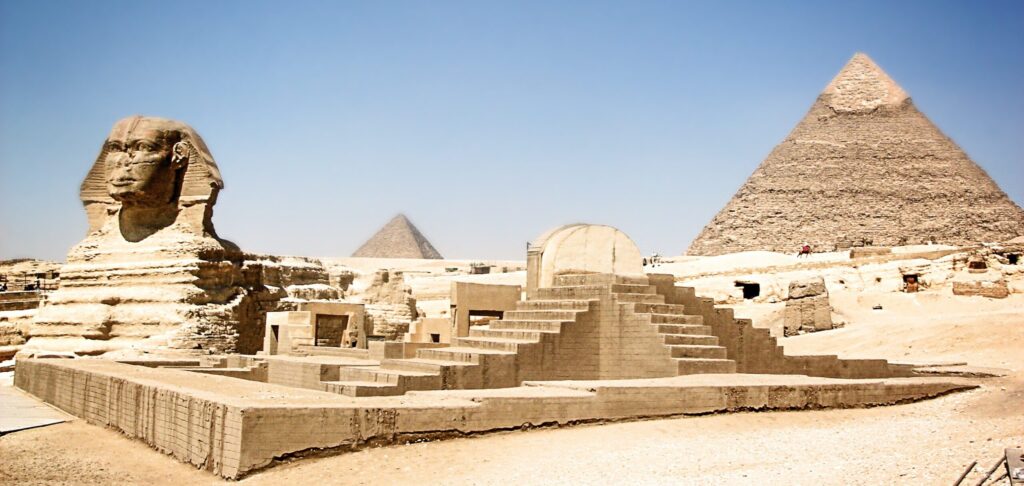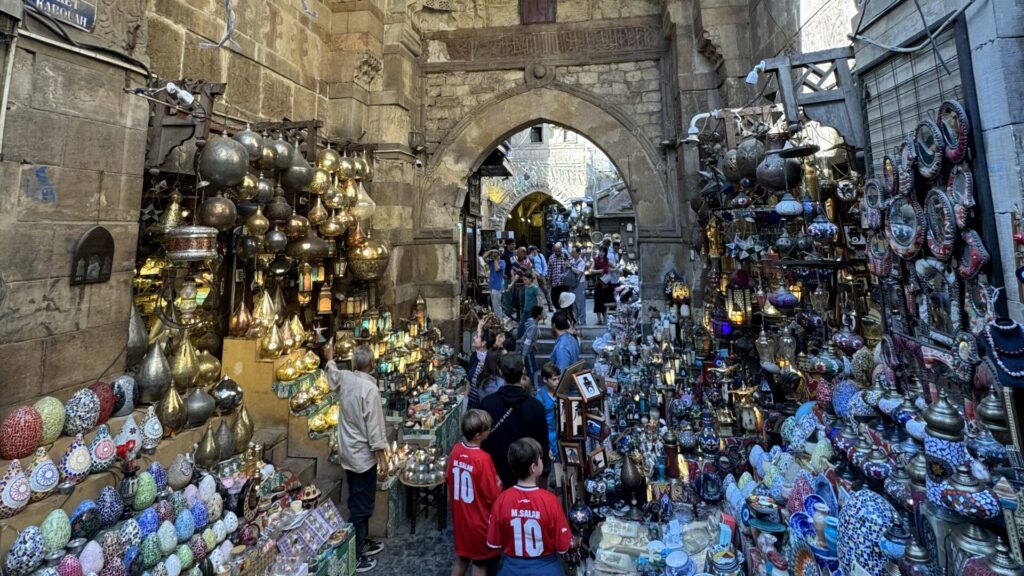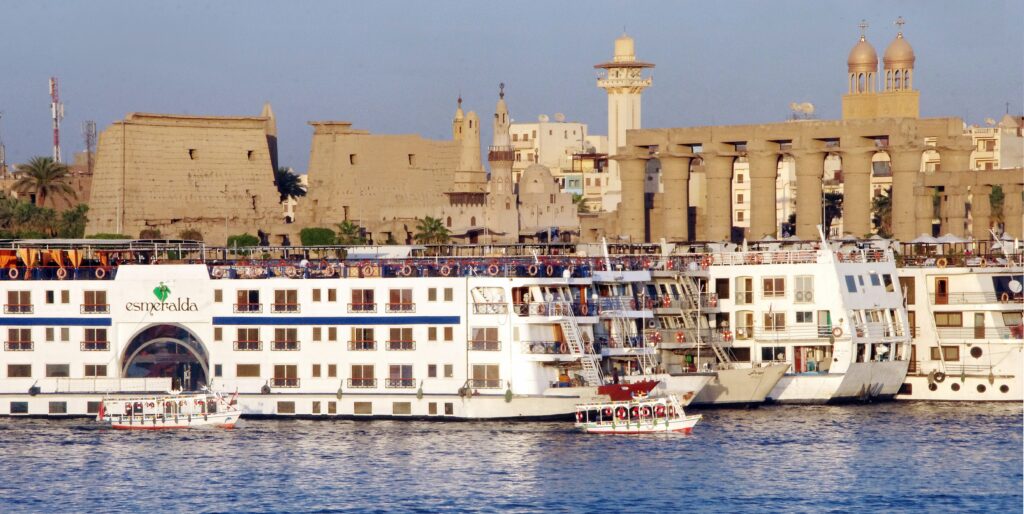When Pharaohs Call
The EgyptAir 787 descends through copper-tinted clouds as Cairo’s impossible sprawl unfolds below—a metropolis where fifteen million souls navigate between minarets and monuments, where street vendors hawk artifacts older than Christianity while smartphones capture selfies with sphinxes. Below, the Nile cuts through desert like a verdant lifeline, the same waters that sustained pharaohs now reflecting satellite dishes and high-rises.
This isn’t tourism. This is time travel.
Cairo: The Heartbeat of Millennia
The taxi from Cairo International delivers you into controlled chaos as dawn prayers echo across a city that never truly sleeps. Nothing—no documentary, no textbook, no virtual tour—prepares you for that first glimpse of the Giza Pyramids rising from suburban sprawl like geometric mountains dropped by gods. Your brain struggles to process the scale. Here, limestone blocks weighing fifteen tons each were lifted by human hands four and a half millennia ago, when most of the world still lived in mud huts.

I arrive at the Giza plateau as sunrise begins its daily resurrection. A guide named Ahmed, whose weathered hands speak of thirty years leading tourists through ancient mysteries, notices my stunned silence.
“First time?” When I nod, he gestures toward the Great Pyramid. “People ask me if these stones ever speak. But you don’t listen to the pyramids—they listen to you.”
The Great Pyramid of Khufu stretches 481 feet skyward, constructed from 2.3 million stone blocks with engineering precision that baffles modern architects. At the Sphinx, I join a queue of pilgrims from every continent, each seeking their moment with humanity’s most enigmatic monument. The limestone guardian, carved from a single massive rock, has watched empires rise and fall for 4,500 years.
But the real magic happens in moments of absolute stillness, when tour groups move on and you’re alone with monuments that predate Christianity by millennia. Standing here makes you simultaneously insignificant and eternal.
Khan el-Khalili: The Bazaar of Wonders
The drive from Giza to Islamic Cairo—thirty minutes through streets where donkey carts share lanes with Mercedes—prepares you for nothing. Khan el-Khalili doesn’t reveal itself gradually; it envelops you like a living organism. Here lies one of the world’s oldest continuously operating markets, where vendors have hawked spices, perfumes, and treasures for seven centuries.
The labyrinthine alleys pulse with sensory overload. Frankincense mingles with cardamom and cumin. Metalworkers hammer brass while their fathers did a thousand years ago. Children dart between carpets hanging like prayer flags while shopkeepers call out in Arabic, English, French, and languages I can’t identify.

At El Fishawy café, I sip mint tea sweetened with memory while backgammon tiles click like castanets. The café, unchanged since 1773, once hosted Nobel laureate Naguib Mahfouz nightly. Here, time moves differently—not forward or backward, but in spirals, like smoke from a thousand shishas.
The sunset call to prayer echoes from a hundred minarets as Cairo’s Islamic architecture reveals itself in golden light. The Citadel of Saladin crowns the city like a medieval crown, while modern traffic swirls below like a mechanical Nile.
The Nile: Lifeline of Legends
The overnight train from Cairo’s Ramses Station—ten hours through darkness toward Luxor—carries you deeper into the mysteries that built a civilization. But this isn’t transportation; it’s transformation. The rails follow the Nile’s eternal course, the same route that carried pharaohs to their tombs in the Valley of the Kings.
Dawn reveals the real Egypt—endless fields of sugarcane and cotton, feluccas with white sails catching morning wind, farmers working land that has been cultivated for five thousand unbroken years. Water buffalo stand knee-deep in irrigation channels while egrets perch on their backs, a scene unchanged since hieroglyphic times.
At Luxor station, the temperature reads 95°F at 7 AM—winter weather in Upper Egypt. The town, built on the ruins of ancient Thebes, feels like an open-air museum where tourists outnumber locals and every street corner hides another temple.
Luxor: Temple of Time
The East Bank reveals humanity’s greatest religious complex. Karnak Temple stretches across 247 acres—larger than most modern cities—where pharaohs spent two millennia adding halls, obelisks, and monuments to honor Amun-Ra. The Hypostyle Hall alone contains 134 columns, each tall enough to hold a four-story building, carved with hieroglyphs that tell stories of gods and kings.
I arrive at Karnak before tourist crowds descend, joining a small group led by Dr. Zahi, an Egyptologist whose passion burns bright as desert sun. “Touch this wall,” he says, placing my palm on hieroglyphs carved 3,400 years ago. “These stones remember Ramesses II. They remember when Moses walked Egypt.”
The Valley of the Kings lies across the Nile, where pharaohs chose eternal rest among limestone cliffs that naturally form pyramid shapes. Tutankhamun’s tomb, modest compared to others, still contains his golden sarcophagus—the boy king who died at nineteen but achieved immortality through grave robbers’ oversight.
But the real revelation comes in the tomb of Seti I, where ceiling frescoes depict the pharaoh’s journey through the afterlife in colors that remain vivid after three millennia. Standing in these chambers makes you understand: the pyramids were just the beginning.
Nile Cruise: Floating Through History
The MS Sonesta Star Goddess departs Luxor as sunset ignites the Nile in molten gold. This isn’t just river transportation—it’s floating through humanity’s longest continuously recorded story. The Nile cruise ships may be modern, but they follow routes pioneered by pharaohs who sailed these waters in barques decorated with gold and lapis lazuli.
My cabin’s balcony overlooks waters that sustained Ancient Egypt for three thousand years. Feluccas still sail past, unchanged in design since pharaonic times. Farmers lead cattle to drink at the same spots where Cleopatra’s barges once moored.
The ship’s dining room serves cuisine that blends pharaonic traditions with modern flavors—roasted pigeon stuffed with rice, ful medames (fava beans) eaten since pyramid times, and fresh dates from palms that might have fed ancient workers.

At night, the ship anchors at Edfu, where the Temple of Horus rises from darkness like a stone dream. Built by Ptolemaic pharaohs—Greek rulers who adopted Egyptian divinity—the temple represents the ancient world’s cultural fusion. Here, Greek architecture embraces Egyptian mythology in stone that defies twenty-two centuries of weather.
Aswan: Where Egypt Ends
The final morning brings Aswan, where the Nile crashes over granite cataracts that marked Ancient Egypt’s southern frontier. Here, pharaohs quarried the pink granite for their obelisks—including the Unfinished Obelisk, abandoned when cracks appeared in the stone. At 137 feet long and 1,200 tons, it would have been the largest ever erected.
The Philae Temple, relocated stone by stone when the High Dam flooded its original island, represents modern Egypt’s commitment to preserving ancient wisdom. Dedicated to Isis, goddess of magic and motherhood, the temple complex required international cooperation to save from Nile waters—archaeology’s greatest rescue mission.
I take a felucca through the cataracts as Nubian boatmen sing traditional songs their ancestors performed for pharaohs. The Nile here runs deep blue against pink granite islands, while golden sand dunes stretch toward Sudan. Here, you feel Egypt’s connection to Africa’s heart.
At the Old Cataract Hotel, where Agatha Christie wrote “Death on the Nile,” I sip gin and tonic on terraces that have hosted everyone from Winston Churchill to Princess Diana. The hotel, unchanged since colonial times, offers perspective on Egypt’s modern transformation.
The Return: What Egypt Teaches
The EgyptAir flight back to Cairo carries me away from landscapes that rewrote my understanding of time, accomplishment, and human persistence. Through my window, the Nile stretches endlessly below—the same waters that sustained pyramids builders and continues nurturing twenty-first-century farmers.
This journey teaches lessons unavailable in museums: that some achievements transcend their creators, that spirituality and engineering can achieve immortality together, that cultures peak when they balance divine inspiration with human skill.
The pyramids teach ambition—monuments that required decades of planning and lifetime commitment. Cairo teaches resilience—a civilization that survived Persian, Greek, Roman, Arab, Turkish, and European conquest while maintaining its essential character. The Nile cruise teaches continuity—the same river that carried pharaohs still carries tourists, connecting past and present in liquid flow. Luxor teaches devotion—temples where priests maintained sacred fires for three millennia.
But Egypt gave me something more: permission to think in centuries rather than quarters, to value permanence over profit, to find divinity in human achievement, and to understand that some places don’t just inspire—they initiate you into mysteries older than recorded history.
Practical Pilgrimage: Planning Your Own Egyptian Odyssey
Getting There:
- EgyptAir: Direct flights from most major cities to Cairo (CAI)
- Alternative: Emirates via Dubai for premium service
- Best season: October-April (avoid summer heat)
- Total duration: 8-12 days for complete experience
The Sacred Route:
- Cairo (3 nights): Pyramids, Egyptian Museum, Islamic Cairo
- Overnight train to Luxor (romantic, authentic)
- Luxor (2 nights): East Bank temples, West Bank tombs
- Nile cruise to Aswan (3-4 nights): Floating palace experience
- Aswan (1 night): Cataracts, Nubian culture
- Return flight Cairo to departure point
Where to Stay:
- Cairo: Four Seasons First Residence or historic Old Winter Palace
- Nile Cruise: Oberoi Zahra or Sonesta Star Goddess (book luxury suite)
- Aswan: Old Cataract Hotel (Agatha Christie’s room still available)
Essential Experiences:
- Sunrise at Giza pyramids (private access worth premium)
- Khan el-Khalili market at sunset (authentic handicrafts)
- Valley of Kings tomb visits (maximum 3 per day, choose wisely)
- Philae Temple sound and light show
- Felucca sailing among Aswan’s granite islands
Cultural Immersion:
- Eat at authentic ahwas (traditional coffee houses)
- Learn basic Arabic phrases (hospitality multiplies)
- Respect prayer times and dress codes at religious sites
- Tip generously (baksheesh is cultural appreciation, not corruption)
Budget Expectations:
- Luxury experience: $4,000-7,000 per person
- Premium cruise suites: $500-1,000 per night
- Private guide services: $150-300 per day
- Entrance fees: $20-50 per major site
The Egyptian Truth: This journey doesn’t just show you monuments—it initiates you into mysteries that predate philosophy itself. You return not just with photographs, but with eternal perspective embedded in your consciousness, with silence that echoes longer than any urban noise.
In Egypt, they say the Nile gets into your blood. After one week among pharaohs and temples, I understand this isn’t metaphor—it’s cellular recognition of humanity’s greatest achievements.
For more details to help you plan your journey explore Egypt Destination Guide.

